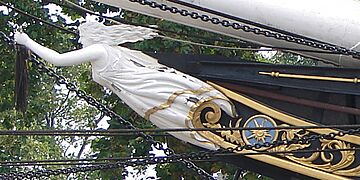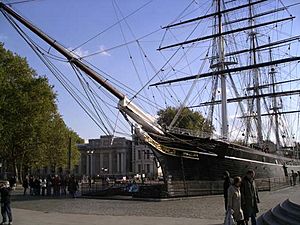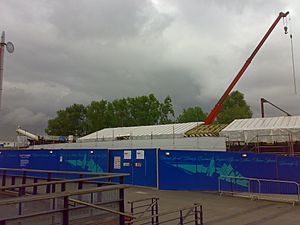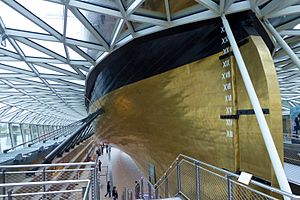Cutty Sark facts for kids
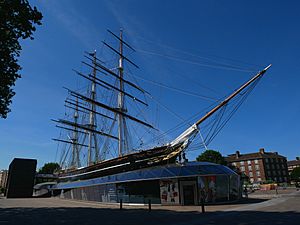
Cutty Sark seen from the north-east
|
|
| History | |
|---|---|
| Name | Cutty Sark (1869–1895) |
| Namesake | Cutty-sark |
| Owner | John "Jock" Willis (1869–1895) |
| Ordered | 1 February 1869 |
| Builder |
|
| Cost | £16,150 |
| Laid down | 1869 |
| Launched | 22 November 1869 |
| Sponsored by | Mrs. George Moodie |
| In service | 16 February 1870 |
| Homeport | London |
| Identification | UK Official Number: 63557 |
| Motto | "When there's a Willis a way" |
| Fate | Sold 1895 |
| Name | Ferreira |
| Namesake | Joaquim Antunes Ferreira |
| Owner | Joaquim Antunes Ferreira & Co. (1895–1922) |
| Acquired | 22 July 1892 |
| Homeport | Lisbon, Portugal |
| Nickname(s) | Pequena Camisola ("Little shirt") |
| Fate | Sold 1922 |
| Name | Maria do Amparo |
| Namesake | Mary, Refuge of Sinners |
| Owner | Companhia Nacional de Navegação |
| Acquired | 1922 |
| Homeport | Lisbon, Portugal |
| Fate | Sold 1922 |
| Name | Cutty Sark |
| Owner | Wilfred Dowman |
| Acquired | 1922 |
| Homeport | Falmouth, Cornwall |
| Fate | Sold 1938 |
| Name | Cutty Sark |
| Owner | Thames Nautical Training College |
| Acquired | 1938 |
| Homeport | Greenhithe, Kent |
| Fate | Sold 1953 |
| Name | Cutty Sark |
| Owner | Cutty Sark Preservation Society |
| Acquired | 1953 |
| Out of service | Became museum December 1954 |
| Status | Museum ship |
| General characteristics | |
| Class and type | Clipper |
| Tonnage |
|
| Displacement | 2,100 tons (2,133.7 tonnes) at 20 ft (6.1 m) draught |
| Length |
|
| Beam | 36 ft (10.97 m) |
| Depth of hold | 21 ft (6.40 m) |
| Propulsion | 32,000 sq ft (3,000 m2) sail (3,000 hp) |
| Sail plan |
|
| Speed | 17.5 knots (32.4 km/h) maximum achieved |
| Complement | 28–35 |
The Cutty Sark is a famous British clipper ship. Clippers were very fast sailing ships designed for speed. She was built in Scotland in 1869 for the Jock Willis Shipping Line. The Cutty Sark was one of the last and fastest "tea clippers." These ships raced to bring tea from China to Britain.
Her name comes from a witch in a poem by Robert Burns called Tam o' Shanter. The witch, Nannie Dee, wore a short shirt, which in Scots is called a "cutty sark."
After steamships became more efficient and the Suez Canal opened in 1869, the tea trade changed. Steamships could use a shorter route. So, the Cutty Sark soon switched to carrying wool from Australia. She held the record for the fastest trip to Britain from Australia for ten years.
Later, she was sold to a Portuguese company in 1895 and renamed Ferreira. She worked as a cargo ship until 1922. A retired sea captain, Wilfred Dowman, bought her and used her as a training ship. In 1938, she became a training ship for cadets at the Thames Nautical Training College.
Since 1954, the Cutty Sark has been a museum ship in Greenwich, London. She is a popular tourist attraction. She is also a very important historical ship, listed as part of the National Historic Fleet. She is one of only three ships from the 1800s built with a special "composite construction" (wooden hull on an iron frame) that are still mostly complete.
The ship has faced challenges, including two fires in recent years. The first was in 2007 during a big restoration project. She was repaired and reopened in 2012. A smaller fire happened in 2014.
The famous Cutty Sark whisky is named after the ship. Her image is on the whisky bottle label.
Contents
Building the Cutty Sark
The Cutty Sark was ordered by John Willis, a ship owner. His company shipped tea from China to Britain. Being fast was very important for tea ships. The first ship to arrive with the new season's tea could get a better price for its cargo. Tea merchants even used the names of fast ships in their advertisements.
The ship was ordered during a time when many tea clippers were being built. This was because taxes on tea had been lowered. In 1868, another new clipper, the Thermopylae, set a speed record. Willis wanted the Cutty Sark to be even faster.
Willis chose Hercules Linton to design and build the ship. Willis had another ship, The Tweed, which he thought was very fast. He believed its front (bow) shape made it special. This bow shape was used for the Cutty Sark. Linton, however, changed the back (stern) to be squarer. This made the stern lift more in big waves, keeping water from washing over the deck.
The contract to build the Cutty Sark was signed in February 1869. The builders were Scott & Linton in Dumbarton, Scotland. The ship was supposed to be finished in six months. However, the company ran out of money. Another company, William Denny & Brothers, took over and finished the ship. The Cutty Sark was finally launched on November 22, 1869.
How the Cutty Sark was built
The Cutty Sark is about 212.5 feet (64.77 m) long. Her hull (the main body of the ship) is very sleek, designed for speed. When she didn't carry heavy cargo, she needed extra weight (ballast) to stay stable. For example, with wool, she carried 200 tons of ballast.
The parts of the ship above the waterline were made of strong East India teak wood. The bottom of the ship used American rock elm. The main support beams (stem and sternpost) were also teak. The deck was made of thick teak wood.
The hull had a special design called "composite construction." It had a wrought-iron frame inside, which made the ship very strong and stiff. This was a new idea in shipbuilding at the time. A strong hull meant less water leaked in, so the crew spent less time pumping. This allowed them to focus more on changing the sails for speed.
The outside of the hull was covered with Muntz metal sheets. This metal helped stop barnacles and other sea creatures from sticking to the hull. A clean hull meant the ship could sail faster.
How Fast Was She?
The Cutty Sark could reach a top speed of 17.5 knots (32.4 km/h; 20.1 mph) (about 32 kilometers per hour). Her best recorded distance in one day was 363 nautical miles (672 km; 418 mi) (about 672 kilometers). This meant she averaged about 15 knots (28 km/h; 17 mph) (28 km/h). She once sailed 2,164 nautical miles (4,008 km; 2,490 mi) in six days!
She was known for being very fast, especially in strong winds.
What's in a Name?
The ship was named after a character in Robert Burns' famous poem, Tam o' Shanter. In the poem, a witch named Nannie Dee wears a very short shirt, or "cutty sark" in Scots.
The ship's figurehead is a carving of Nannie Dee. She has long black hair and is holding a grey horse's tail. In the poem, she chases a farmer named Tam o' Shanter. She grabs his horse's tail just as he escapes by crossing water.
The ship also had a motto on its stern: "When there's a Willis a way." This was a clever play on words, using the owner's last name, Willis.
A Journey Through Time
Early Tea Races
The Cutty Sark was built for the tea trade. This was a seasonal business where ships raced to bring valuable tea from China to London. Even though the special bonus for the first ship to arrive ended in 1866, faster ships still earned more money.
Her first big trip started in February 1870. She carried wine and beer to Shanghai. On the way back, she carried over a million pounds of tea. This journey took 109 days.
The Cutty Sark made eight round trips in the tea trade.
| Year | From | To | Days |
|---|---|---|---|
| 1870 | Shanghai | Beachy Head | 109 |
| 1871 | Shanghai | North Foreland | 107 |
| 1872 | Shanghai | Portland | 120 |
| 1873 | Shanghai | Deal | 116 |
| 1874 | Woosung | Deal | 118 |
| 1875 | Woosung | Deal | 122 |
| 1876 | Woosung | Start | 108 |
| 1877 | Woosung | Scilly | 122 |
Steamships Take Over
The Cutty Sark was launched the same year the Suez Canal opened in 1869. This canal made the route from Asia to Europe much shorter for steamships. Sailing ships, especially clippers, found it hard to use the canal. They still had to sail all the way around Africa.
Steamships also became much better and more fuel-efficient. They could travel faster and more predictably than sailing ships. This meant steamships could charge nearly twice as much to carry tea. They also had lower insurance costs.
Because of this, fewer and fewer tea clippers sailed to China each year. Many were sold or used for other types of cargo.
The Great Race Against Thermopylae
One of the Cutty Sark's most famous moments was her race against the Thermopylae in 1872. Both ships left Shanghai on the same day, June 18. They were very similar in size.
Two weeks into the race, the Cutty Sark was ahead by about 400 nautical miles (460 mi; 740 km). But then, a huge storm hit after she passed through the Sunda Strait. The ship lost her rudder!
Captain George Moodie refused to go to port for repairs. Instead, the ship's carpenter, Henry Henderson, built a new rudder at sea. This took six days of hard work in terrible weather. The crew worked bravely, even as waves crashed over the ship.
The Cutty Sark finally arrived in London on October 18, just one week after the Thermopylae. Even though she didn't win, the captain and crew were praised for their amazing effort. Henderson received a £50 bonus for his skill. This was the closest the Cutty Sark ever came to winning the tea race.
Life at Sea and New Journeys
After the tea trade declined, the Cutty Sark had to find new cargoes. She carried coal, jute, and other goods around the world. In 1880, some of her sails were removed to make her easier to manage with a smaller crew.
Life on board could be very tough. There was an incident in 1880 where a crew member was killed. The captain at the time, James Wallace, later took his own life. These events show the difficult conditions sailors faced. A new captain, William Bruce, was not good at his job. He was later replaced by Captain Moore.
The Wool Trade Era
In 1883, the Cutty Sark started a new career carrying wool from Australia to Britain. She made the trip from Newcastle, New South Wales, to London in just 83 days. This was 25 days faster than any other ship that year! This marked the beginning of her time in the wool trade.
From 1885 to 1893, Captain Richard Woodget commanded the Cutty Sark. He was an excellent captain who found even faster routes. He sailed further south to catch the strong winds of the Roaring Forties. This meant facing icebergs and fierce storms, but it made the ship incredibly fast.
The Cutty Sark was the fastest ship in the wool trade for ten years. She once even overtook a modern steamship that was traveling at 15-16 knots!
| Year | From | To | Days |
|---|---|---|---|
| 1883–84 | Newcastle, NSW | Deal | 82 |
| 1884–85 | Newcastle, NSW | Dock | 80 |
| 1885 | Sydney | Downs | 73 |
| 1887 | Sydney | Lizard | 70 |
| 1887–88 | Newcastle, NSW | Lizard | 69 |
| 1888–89 | Sydney | London | 86 |
| 1889–90 | Sydney | London | 75 |
| 1890–91 | Sydney | London | 93 |
| 1891–92 | Sydney | Lizard | 83 |
| 1893 | Sydney | Antwerp | 98 |
| 1893–94 | Sydney | Hull | 93 |
| 1894–95 | Brisbane | London | 84 |
As Ferreira and Maria do Amparo
Eventually, steamships also took over the wool trade. In 1895, the Cutty Sark was sold to a Portuguese company for £1,250. She was renamed Ferreira. Her crew sometimes called her Pequena Camisola, which means "little shirt" in Portuguese, just like her original name.
The ship carried various goods between Portugal, South America, Africa, and Britain. In 1916, she lost her masts in a storm off the Cape of Good Hope. Because of World War I, it was hard to find new masts. So, she was re-rigged with a different sail plan, becoming a barquentine.
By 1922, Ferreira was the last clipper still working in the world. She was caught in a storm and sailed into Falmouth harbour in England. There, a retired captain named Wilfred Dowman saw her. He was determined to buy her.
She returned to Lisbon, Portugal, and was briefly renamed Maria do Amparo. But Dowman succeeded in buying her for £3,750.
A Training Ship for Cadets
After Dowman bought her, the Cutty Sark was brought back to Falmouth. Her original rigging was mostly restored. She was then used as a training ship for young cadets learning to sail. She was also opened to the public as a historic ship.
When Wilfred Dowman died in 1936, his wife, Catharine Dowman, gave the ship to the Thames Nautical Training College. She also gave £5,000 for its upkeep. The Cutty Sark was towed to Greenhithe to join HMS Worcester as an auxiliary training vessel.
By 1950, she was no longer needed as a training ship. In 1951, she was moved for a refit and displayed at the Festival of Britain. In 1952, a tanker accidentally collided with the Cutty Sark in the Thames. Her bow was damaged, and her figurehead lost an arm, but it was later repaired.
The Cutty Sark as a Museum
In 1953, the Cutty Sark was given to the Cutty Sark Preservation Society. In 1954, she was moved to a special dry dock in Greenwich, London. To make her lighter for the move, her upper masts, yards, and other parts were removed. An 83-year-old captain, C.E. Irving, who had sailed on her three times as a young man, was the skipper for this final journey.
The dry dock was then sealed, and the ship was re-rigged. The goal was to restore her to how she looked in her sailing days. This restoration and preparation for public display was a huge project.
Today, the Cutty Sark is a famous museum ship and a popular tourist spot. She is located in Greenwich, near the National Maritime Museum. She is also a well-known landmark for events like the London Marathon. She often flies signal flags that spell out "JKWS," her code in the International Code of Signals.
The Cutty Sark Trust looks after the ship. The Duke of Edinburgh helped set up the Cutty Sark Society in 1951 to save her. The ship is a Grade I listed monument. Beneath the ship, there is a large collection of ships' figureheads, which were donated in 1953.
You can easily visit the Cutty Sark by using the Cutty Sark DLR station or by taking a river boat to Greenwich Pier.
Restoration and Fires
By the early 2000s, the Cutty Sark needed major repairs. Her iron frame was corroding, and the hull was changing shape because of how it rested in the dry dock. A big conservation project was planned to fix these issues. This included strengthening the frame and finding a new way to support the ship.
On May 21, 2007, while undergoing this work, the Cutty Sark caught fire. The London Fire Brigade worked for hours to put it out. Initial reports suggested a lot of damage. However, much of the ship's original wooden structure had already been removed for the restoration work. This meant less of the original ship was lost than first thought.
Investigators later found that the fire was most likely caused by an industrial vacuum cleaner. It had probably been left running over the weekend. There were also no overnight fire watchers on duty. The total cost of the restoration project increased significantly after the fire.
On October 19, 2014, another smaller fire broke out on the ship's deck. Firefighters quickly put it out, and the ship reopened soon after.
New Ways to See the Ship
As part of the restoration, the ship was raised about 3 metres (10 ft) (10 feet) above its dry dock. This created a new museum space underneath the hull. Visitors can now walk beneath the ship and see its unique shape from below.
The project involved a lot of new steelwork to support the ship and create new visitor areas. A glass-encased lift and new staircases were added. Visitors now enter the ship through a new opening in the hull below the waterline.
The restoration project cost a lot of money. The Heritage Lottery Fund and many generous donors, including Sammy Ofer and Jerry Bruckheimer, helped raise the funds.
Mast Details
The Cutty Sark had different mast setups depending on her journey. When she was a tea clipper, she had a "tea rig." This meant she had a very large area of sail to catch every bit of wind. This was important for speed, especially in calm areas of the ocean.
When she sailed to Australia with wool, she used a smaller rig. The strong winds on that route meant she didn't need as much sail area. A smaller rig also cost less to maintain. Each of her three masts (fore, main, and mizzen) was made of three overlapping sections.
| Tea Rig | Sydney | |
|---|---|---|
| Foretop | 18.8 | 16.5 |
| Topgallant | 29.8 | 24.3 |
| Royal | 39.6 | 35.4 |
| Maintop | 19.8 | 16.9 |
| Topgallant | 31.9 | 22.8 |
| Royal | 36.3 | |
| Skysail | 44.5 | |
| Mizzentop | 17.0 | 14.8 |
| Topgallant | 25.7 | 22.8 |
| Royal | 33.2 | 31.7 |
| Tea Rig | Sydney | |
|---|---|---|
| Fore course | 23.8 | 21.0 |
| Lowertopsail | 20.7 | 16.8 |
| Uppertopsail | 19.5 | 14.6 |
| Topgallant | 14.6 | 11.5 |
| Royal | 11.6 | 9.4 |
| Main course | 23.8 | 21.6 |
| Lowertopsail | 20.7 | 18.5 |
| Uppertopsail | 19.5 | 16.8 |
| Topgallant | 14.6 | 14.2 |
| Royal | 11.6 | 10.4 |
| Skysail | 10.4 | |
| Mizzen course | 18.3 | 17.4 |
| Lowertopsail | 16.5 | 14.9 |
| Uppertopsail | 14.6 | 13.4 |
| Topgallant | 11.9 | 11.0 |
| Royal | 10.1 | 8.2 |
| Spanker | 15.8 | 14.1 |
Images for kids
See also
 In Spanish: Cutty Sark para niños
In Spanish: Cutty Sark para niños
- Falls of Clyde
- Gipsy Moth IV
- List of clipper ships
- List of large sailing vessels
- List of ships built by William Denny and Brothers
- Star of India
- William Pile



